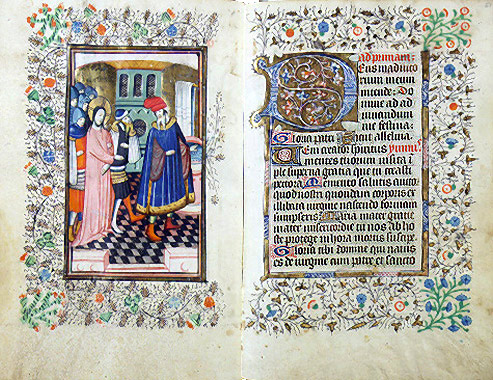Bruges, 1430-1450
Although the liturgy of this Book of Hours is of English use, and calendar notations and a lengthy added rubric in Middle English speak to its English provenance, it seems likely that the manuscript was used by an outcast community of English Catholics on the Continent, not in England, after the Reformation. The binding appears to be Continental; there is a French inscription on the flyleaf; the name of St. Thomas of Canterbury has not been effaced (it was often damaged in English Books of Hours after the advent of Protestantism); and the illuminations have been confidently ascribed to Bruges.
As was common in this period, the illuminations in this Book of Hours were produced in a different workshop from the rest of the manuscript, purchased individually and sewn into the manuscript when it was bound. Of extraordinary importance is that all fifteen miniatures in this manuscript are signed with printed marks by the artist, a very rare feature that provides some insight into the mechanics of the booktrade at the time. The miniatures are by the Master of Otto van Moerdrecht, or by one of the artists in his circle. The printed mark in the upper right corner of each miniature (a white letter [I] within a red-filled circle) was a registered trademark, used in accordance with a Bruges statute requiring artists to use such stamps to identify their work as actually having been created in Bruges. This was in part an attempt to stem the flow of miniatures imported from other centers such as Utrecht. The trademark served the same function as a "Made in America" label--to keep business at home. Relatively few artists took this regulation seriously--these marks are rare--but their use here is a valuable record of the political climate surrounding the thriving book trade in the first half of the fifteenth century. The miniature shown here precedes the Prime office. A group of soldiers lead Christ before Pilate, who prepares to wash his hands in the basin to the right. The artist's mark is clearly visible in the upper right corner.
Fig. 1: Parchment, 179 folios, 189 x 128 (107 x 70) mm, 1 column, 19 lines, in Latin, written in Gothic script.
